GoPro Hero 10 review: Harder, better, faster, slower (motion)
Almost exactly 10 years go, we reviewed the GoPro HD Hero 2. It wasn’t the first flagship camera from the company, but I’d argue it was instrumental in bringing the GoPro to the attention of the general public. Back then, the maximum resolution was 1080p, photos topped out at 5-megapixel and it came shrouded in that iconic waterproof housing.
A decade later, the Hero 10 Black (revealed today) offers a whopping 5.3K max video resolution, 23-megapixel photos, no longer needs a waterproof housing (for most uses) and has a slew of fancy shooting modes that we couldn’t even have imagined three presidents ago.
Pros
- Improved image quality
- More slow-mo and frame rate options
- faster user interface
- hydrophobic lens coating
Cons
- Battery life has taken a hit
- slightly more expensive than last year’s flagship
Before we get to the review part, though, you likely want to know what else has changed. The headline feature is clearly the new GP2 processor. GoPro started using its homegrown chip, the GP1, a few years ago. Now, the second iteration is here and brings with it a boost in frame-rates across the board (5.3K at 60; 4K at 120 and 2.7K at 240 to name a few).
Even the front-facing display benefits from an increased frame rate, which should make your previews smoother. GoPro also states that the GP2 brings with it an image processor (ISP) that promises improved quality photos and videos. We’ll be the judge of that, of course.
James Trew / Engadget
You may have noticed that the max resolution for video is now a shade higher than last year at 5.3K (up from 5). We’re told the sensor is actually the same as before, but that the new chip running the show can eke out more use of it.
The camera itself is, thankfully, the same dimensions as the Hero 9 which means if you have a media mod or Hero 9-specific accessory it’ll likely work with the new model just fine. In fact, the only visible differences between last year’s model and the Hero 10 is… the number 10 and the color of the text branding — it’s now GoPro blue rather than gray.
GP2 times the power
The GP1, GoPro’s first custom processor, made its debut with the Hero 6 Black. It allowed the company to tightly integrate the brains of the camera with the rest of the hardware and yield more control over key features. With the GP2, the promise is “twice the performance.” The company hasn’t shared specifics about the chip itself, but the rewards are evidenced in the increased frame rates across the board. I already mentioned that the upper-most resolution is now .3 megapixels higher than last time and available at 60fps. Twice the frames of the equivalent on the Hero 9 Black.
There are other benefits to the new chip beyond FPS, though. Not least, it’s paired with that ISP which we’ll go into in more detail next. The GP2 also powers the updated HyperSmooth 4.0, and promises a slicker user interface and faster offloading of media (again, each of these will get its own section).
Image quality
While GoPro is touting the new framerate modes as one of the key upgrades this time around, I feel the image quality is worth tackling first — this is a camera after all. The good news is that it’s markedly better than the Hero 9. It’s tempting to assume that the higher resolution for both video and photos is to thank here, but there’s some other processing grunt going on in the background.
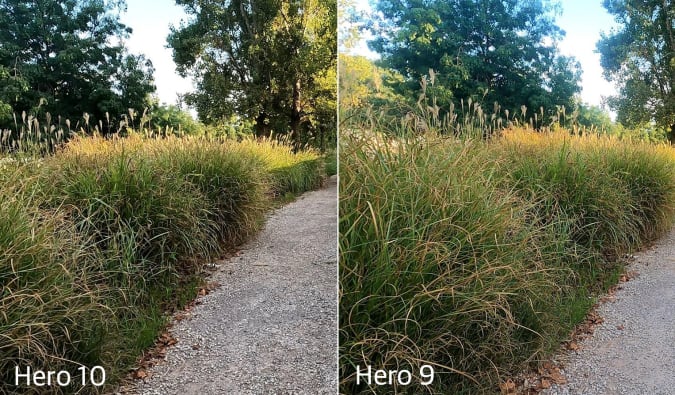
James Trew / Engadget
According to GoPro, new algorithms for tone mapping and noise reduction are also responsible for the bump in quality. All I know is that both videos and photos look better, and in a meaningful way. When I was reviewing my comparison footage, color reproduction was a lot more faithful without looking flat. Somehow natural and inorganic tones (say, buildings and trees) look deeper. On top of that is the fidelity. When I viewed images at 100-percent crop, the difference in detail was instantly obvious. Where some textures, like road surface or leaves, on the Hero 9 can smooth out when they’re not the primary subject of the video, on the Hero 10 you can spot features that aren’t present in last year’s camera.
Higher resolutions
On top of the general improvement in image quality is the added flexibility that comes with the new resolution and framerate combinations. The Hero 9 topped out at either 5K/30fps in 16:9 or 4K/30 at 4:3. Not bad. But the Hero 10 offers a pretty substantial increase with 5.3K/30fps or 4K/60 at 4:3 and 5.3K/60 when shooting in 16:9. That’s a lot of jargon, but essentially it means you have a lot more headroom for both 16:9 and 4:3 aspect ratios. And given that 4:3 is great for POV shots, a staple of the action world, that’s good news for your videos.
It’s easy to wonder why you might even want 5.3K video, given there’s not a lot you can natively play it back on. But more pixels is never a bad thing and you can scale something down to a more “conventional” resolution later or crop to 4K without losing quality. You now even have something close to slow-mo at 4K (60fps) in the 4:3 aspect ratio which is a first for a GoPro.
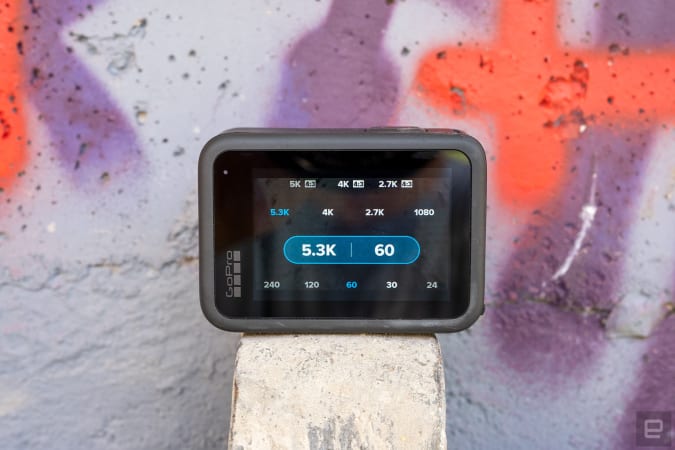
James Trew / Engadget
Then, of course, there’s that increase in photo resolution that we already mentioned. Three whole megapixels is a decent improvement from last time around and if you pull stills from video on the regular you’ll enjoy higher resolution there, too (the change varies depending on your video settings, but it’s an increase across the board).
More frames
Finally we can get to one of the marquee upgrades: Frame rates. With GP2 onboard, 4K video is now available at 120fps, giving the Hero 10 a respectable slow-mo mode for the first time at UHD. Last year’s camera could eke out 60fps at 4K, but 2X isn’t really enough to show off your laser flips in all their mind-boggling glory. The new 4X slow-mo at this high resolution is going to really show off your best moves. The new 120fps mode is available with almost all the field-of-view options, which GoPro calls “lenses,” bar SuperView which tops out at 60fps. 2.7K also gets a boost from 120fps to 240 — the max the camera can do, making this a great balance of resolution and framerate for action.
Of course, a high frame rate isn’t only about slow-mo, that’s just a common application for it on an action camera. A higher FPS also helps keep your videos looking smooth at normal speed, especially if there’s a lot of activity going on — which, again, seems quite likely with a GoPro. For example, I shot some videos on a bike ride at 4K/30fps and then some more later at 60fps and the sense of motion at the higher frame rate is noticeably much smoother even when played back at normal speed.
In short, frame rate is another tool in the box when it comes to lining up your shot so it’s great to see far more options here. It also means you don’t have to make a choice between FPS or high resolution nearly as much as you did in the past.
HyperSmooth 4.0
In a darker age, GoPros had no onboard stabilization. It meant handheld footage had to be shot with extreme care, and every twitch, pothole or wobble was recorded in great clarity. That was fine for some activities, but often it just meant you ended up with unusable footage or a spell in post to try and salvage things.
Since the Hero 7, we’ve lived in a lighter, brighter world where HyperSmooth would work its magic and make even the most jarring pursuit look slick and smooth on video without having to use a pricey, fragile gimbal. With the Hero 10 we’re now on the fourth revision of GoPro’s onboard stabilizing and it continues to work wonders.
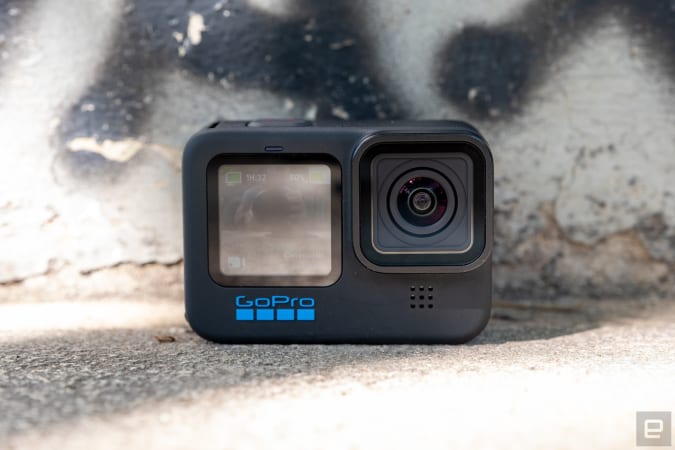
James Trew / Engadget
Perhaps the most notable change here is the increased power of horizon levelling. Before, it would keep videos “flat” to the skyline up to about 27 degrees. After that, it’d gently tilt your video to match the angle of the camera. Now, you can hit a curve or ride a corner at 45-degrees and your video will steadfastly lock to the horizon.
As with all things, just because you can, doesn’t mean you (always) should. I like using horizon levelling with mounts, selfie sticks or anything that can easily go off-level while holding. In contrast, you could use it while mounted to handlebars, for example, but any tight turns or dramatic leans will get neatly ironed out. You’ll have a smooth video for sure, but it loses a little of the action dynamic. Fortunately, you can decouple horizon levelling from HyperSmooth right on the home screen of the camera so it’s right there when you need it (or don’t).
Front screen
All new on the Hero 9 was the addition of a front screen for framing yourself when looking at the camera. DJI came out of the gate with one on its Osmo Action, beating GoPro to market by weeks. Nonetheless, it’s now a mainstay feature and thus, subject to upgrades, too.
The one on the Hero 10 is the same size as last year, but with a small increase in frame rate — from 20fps to 30. It’s nice to see the company updating all aspects of the camera, but I personally don’t notice much difference, certainly not at arm’s length, which is most of the time I find myself needing that second display. Either way, if you found the screen a little lacking in this regard, just know that there’s likely a better experience for you this time around.
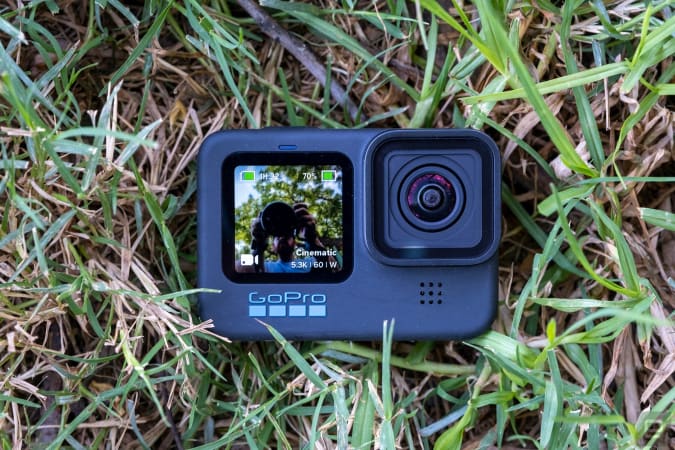
James Trew / Engadget
Not so much a feature of the front screen, but it relates to the front, so here is the time to mention it: The Hero 10 now has an “hydrophobic” coating on the lens. If you’ve ever taken a GoPro into the water, you’ll know that drops on the lens are the fastest way to ruin your footage. They normally sit just where the action is taking place, too.
I haven’t been able to give this camera the full water test yet, but simply getting it wet, you can tell that water doesn’t gather in the large, subject-blurring drips as it did before. It’s not entirely water repellant, but big drops are a thing of the past, instead the worst you get is a collection of smaller droplets. These are still undesirable, but they seem to have less impact on what you’re shooting, so I’ll take it.
Faster navigation
Another light improvement is in the user interface and menu navigation. GoPro claims the touch screen is now more responsive and most tasks should be quicker. This definitely does appear to be the case. Older cameras sometimes need two (or even three) attempts for a press to be registered, but with the Hero 10 there were far fewer occasions where I found myself needing to tap more than once.
An even clearer example of the software side of things being more rapid is the amount of time it takes to process an HDR photo. While the exposure is instant, GoPro owners will be familiar with the swirling circles after an image is taken while the camera develops the photo. It’s not long, usually a couple of seconds, but with the Hero 10 that time is about cut in half. Between that and the general nippiness of the menus, the latest flagship definitely feels a little breezier to use.
One other small usability change that doesn’t technically fit here, but adds to the user experience is that the Hero 10 now allows for good old fashioned wired transfer. That is, simply connect the camera to your computer and it’ll show up as removable storage with direct access to your media. It’s kinda hard to believe that this wasn’t a thing before, but I double checked with my Hero 9 and, nope, nothing — you have to get handsy with the memory card and an adapter. Small graces, but we love to see it.
Battery life
Everything has been quite positive so far, so it’s time for a small spanner in the works. Battery life has never really been GoPro’s strong suit, although it has generally improved over time. Alas, the Hero 10 feels like a small step backward. It’s not deal-breaking levels, but on a straight “click record and leave the camera” shoot out, the Hero 9 outlasted the Hero 10 by almost half an hour — clocking in at 1hr40 at 4K/30fps. When I did the same test (with the same actual battery) on the new camera, it only managed 1hr15.
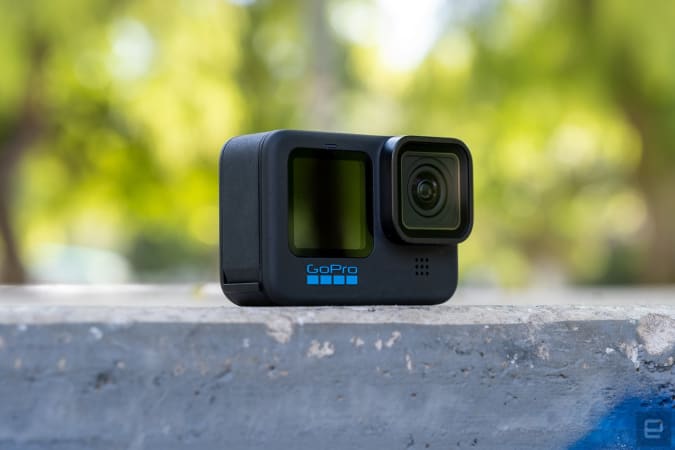
James Trew / Engadget
GoPro, for its part, claims that most users are only shooting short videos and it’s optimized the camera (and its battery usage) for that scenario. That might be true, but one must presume that that hasn’t changed since the last camera. And regardless of your shooting habits, the physics of higher processing will always diminish your overall shooting time.
Things get even worse once you start flirting with those new higher frame rates. On my first day out testing I thought I might have a duff cell as it sunk to about 50-percent battery unusually quickly. It was only later that I confirmed that this is just the price to pay for smoother videos.
There’s not a lot more to add here, as this is somewhat to be expected: You’re asking a battery of the same capacity to do a lot more work. Let’s hope that future revisions and maybe even some software updates can claim back some of those precious lost minutes.
Price
Last year, GoPro tried something… different, when it came to pricing. If you bought the camera on its own, it cost $450. That was a little higher than the flagship it replaced (the Hero 8 sold for $399 at launch). BUT, and it was a big but, if you were willing to sign up for a GoPro subscription at the same time, the total price you paid was $350 — which suddenly felt like a solid deal.
The same deal is in place this time around, just it’s $50 more expensive. The camera and subscription bundle now costs $399 and the camera on its own is $499. Given how easy the company is making it for you to get that subscription though — if you have an active subscription already, you’ll get the subscription price — it’s fairly easy to get the lower price. In short, make sure you snag a subscription or already have one when you order.
Ultimately, the Hero 10 isn’t the cheapest flagship at launch, but neither is it the most expensive — that honor goes to the Hero 6 which cost $499 with no route to pay less. GoPro reduced that price to $400 though soon after launch. It might sting a little that it’s more cost than last year’s, especially if you’d been hoping to get the latest and greatest for the same price, but with general improvements the whole way round it’s likely not something you will dwell on for long — especially as the Hero 9 will retain that $350 price tag along side the Hero 10 as the now “mid-tier” option.
Wrap up
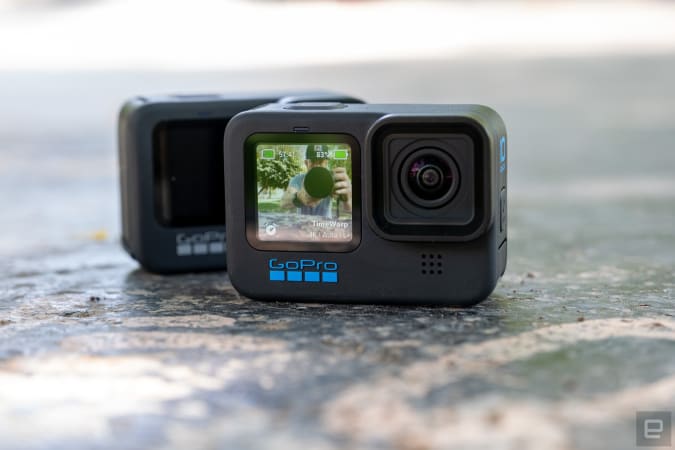
James Trew / Engadget
For a spell, it looked like DJI was going to maintain the pressure on GoPro with its Osmo Action line. But so far it seems like it’s taking its time when it comes to new models — although you can pick up the original for $200 now, which makes it attractive if price is your main concern. Likewise, Sony seems to have taken its foot off the gas when it comes to refreshing its own, quite popular, line of action cameras. There is, of course, also Insta360, which has gained a solid fan base thanks to its unique form-factors and modular model.
It’s a familiar ending here, then. The new camera takes everything that’s working and builds on it. Especially in the areas that matter: Image quality and shooting modes. That’s all we can really ask for. The fact that there are many other usability tweaks is just an added bonus. The apparent dip in battery life, while not ideal, will only really be an issue if you use those new frame rates as standard. As for the price, we’d love for it to have stayed the same as last year’s launch, but the increase isn’t into unrealistic territory.
All products recommended by Engadget are selected by our editorial team, independent of our parent company. Some of our stories include affiliate links. If you buy something through one of these links, we may earn an affiliate commission.
For all the latest Technology News Click Here
For the latest news and updates, follow us on Google News.
